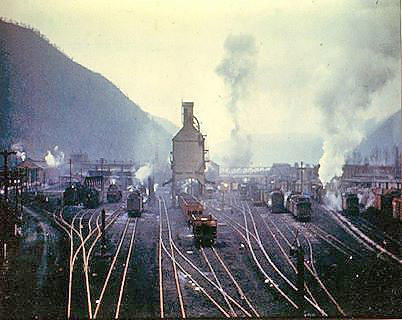NYC, including the Big Four (CCC&STL) became completely dieselized for passenger service immediately after an order for EMD GP9's arrived. the last 20 Hudsons assigned to the Big Four were laid up by March, 1956. I understand that late Mohawks were at times assigned to passenger runs if diesels became unavailable after March, 1956. NYC became completely dieselized in May, 1957 with the retirement of H-7 Mike at Riverside Yard. (There was steam on the property later than August, 1958 when I visited Sharonville, OH and Riverside in Cincinnati. All I found were a few L-2 Mohawks, Mikados, and 0-8-0 switchers.)
I agree that an N&W J would have made an excellent passenger engine on the Pittsburgh Division.
During the several years before the merger of NYC and PRR, both railroads made efforts to streamline operations and their physical plants. PRR went to intermodal (Truc-Train) on its mainline, with clearances capable of providing this service. NYC could not do standard "intermodal" due to low clearances, principally east of Buffalo, so under Perleman was invented (Super-Van), or truck trailers without rubber tires. Both railroads together closed over 88% of their locomotive maintenance facilities, understanding very late in the game that a locomotive shop and roundhouse was not required at every Division point ("every 100 miles") for diesels. (NYC built a new diesel facility at Ashtabula OH in 1952-53? when their main shop at Collinwood was less than 40 miles west.......!)
NYC adopted CTC and reduced mainline trackage from four tracks to two in order to reduce taxes. From what I read regarding the number of diesels requiring shopping in one of Al Staufer's books, PRR just quit most maintenance. (One the date of the merger, PRR had over 1800 diesels that required shopping-from my memory.)
Remember, the gov't set all freight rates, and any relief required an individual petition and could take years to receive a reply......
And of course the unions fought all of this, starting with the elimination of cabooses (mostly a Penn-Central and Conrail initiative). Remember "featherbedding"?
The guys who ran these two organizations certainly weren't idiots, but they did not have a lot of room to maneuver. As for Perleman, I heard from many NYC employees that, because of his management style, he was universally hated.
Finally, I think that Perleman's decision to not save either a Hudson or a Niagara is just inexcusable and unfathomable........and the one decision that he made that will remain with him "forever".






